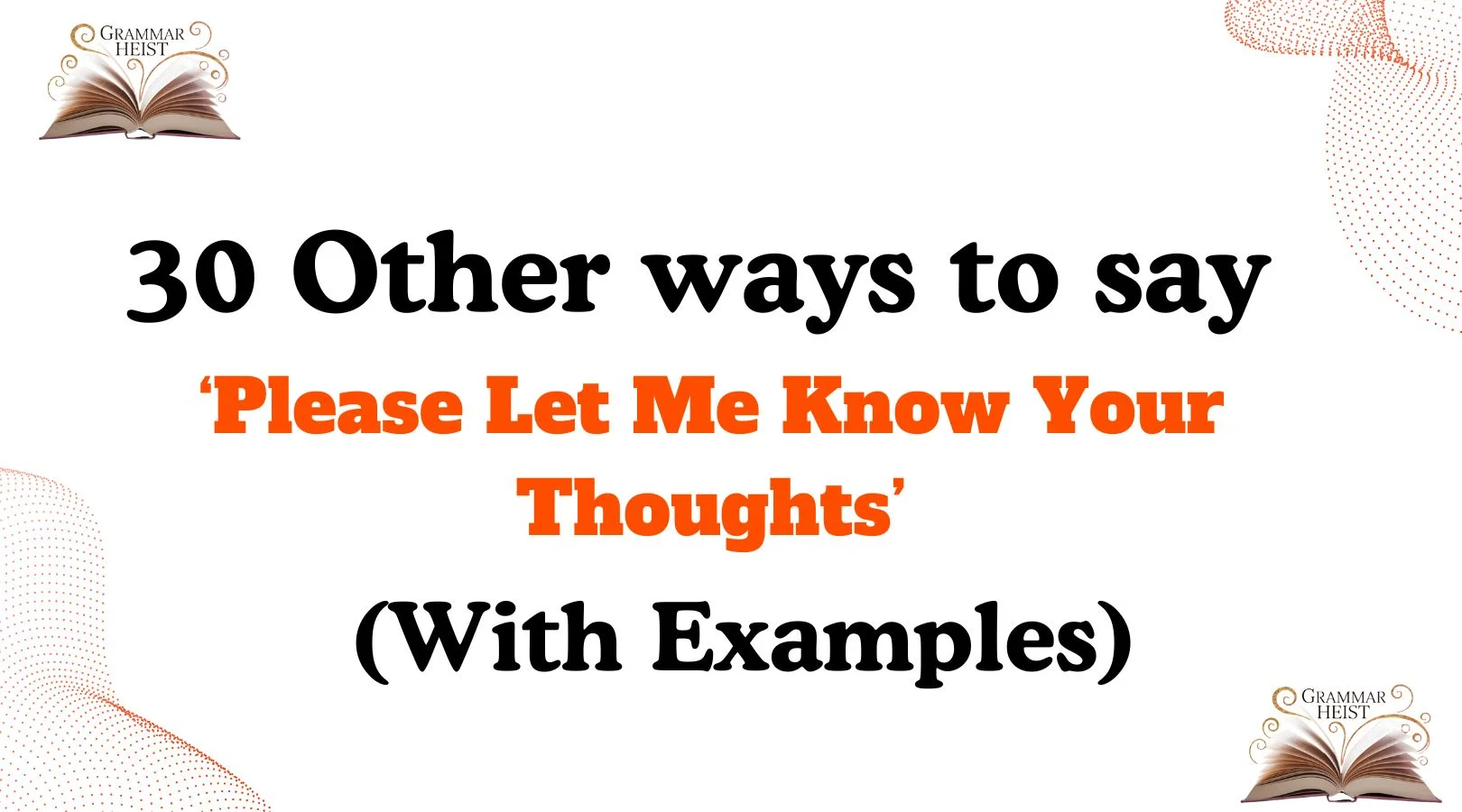Finding the right words in communication can make all the difference. Saying “Please let me know your thoughts” is polite and useful, but sometimes you may want to use warmer, more personal, or professional alternatives. Choosing the right phrase can help you express care, invite collaboration, and show that you truly value the other person’s opinion.
In this article, we’ll explore 30 other ways to say “please let me know your thoughts” with examples, tone, and explanations, so you can use the best option depending on the situation.
What Does “Please Let Me Know Your Thoughts” Mean?
The phrase “please let me know your thoughts” is a polite way to ask for someone’s feedback, opinion, or perspective. It’s often used in emails, workplace communication, or even casual conversations to show that you are open to ideas and want to include the other person’s input.
Is It Professional/Polite to Say “Please Let Me Know Your Thoughts”?
Yes, it is both professional and polite. However, depending on the context, it may feel too formal or too neutral. That’s why having alternatives can help you adapt to more casual, caring, or thoughtful tones.
Pros or Cons
Pros:
- Shows openness and respect for the other person’s opinion
- Professional and widely accepted
- Works in both personal and business settings
Cons:
- Can sound too formal or overused
- May lack warmth or personalization
- Could feel generic if used too often
Synonyms For “Please Let Me Know Your Thoughts”
- I’d love to hear your feedback
- What are your thoughts on this?
- I value your opinion
- Could you share your thoughts?
- I’d appreciate your feedback
- Let me know what you think
- I’m curious about your perspective
- I welcome your input
- How do you feel about this?
- I’d be grateful for your feedback
- What’s your take on this?
- I’d like your honest opinion
- Could you give me your thoughts?
- I’d love to hear your perspective
- Do you agree with this?
- Your feedback would mean a lot
- I’d love your input
- I’m open to your suggestions
- How do you see this?
- I’d like to hear your thoughts
- Your perspective matters to me
- Could I get your feedback?
- I’d like your point of view
- How does this sound to you?
- I’d be happy to hear your feedback
- Do you have any suggestions?
- I’d love your honest thoughts
- I’m interested in your view
- Can you share your feedback?
- Your thoughts would be valuable
1. I’d Love to Hear Your Feedback
Scenario: Great for workplace or professional emails.
Examples:
- “I’d love to hear your feedback on the proposal.”
- “Your insights are valuable—I’d love to hear your feedback.”
- “I’d love to hear your feedback before moving forward.”
Tone: Friendly and professional.
Explanation: This phrase shows that you are genuinely interested in what the other person has to say. It emphasizes appreciation and collaboration.
2. What Are Your Thoughts on This?
Scenario: Direct but polite, works well in both casual and formal contexts.
Examples:
- “What are your thoughts on this plan?”
- “I’d love to know—what are your thoughts on this?”
- “Before we finalize, what are your thoughts on this?”
Tone: Conversational and neutral.
Explanation: This is a simple, straightforward way to invite input without sounding too formal. It works across both professional and personal conversations.
3. I Value Your Opinion
Scenario: When you want to emphasize respect and appreciation.
Examples:
- “I value your opinion on this project.”
- “Your experience matters—I truly value your opinion.”
- “Before I decide, I value your opinion.”
Tone: Respectful and appreciative.
Explanation: This phrase highlights that the other person’s perspective is important to you. It adds warmth and makes them feel recognized.
4. Could You Share Your Thoughts?
Scenario: Professional but softer in tone, useful in formal emails.
Examples:
- “Could you share your thoughts on the proposal?”
- “I’d appreciate it if you could share your thoughts on this draft.”
- “Before we move forward, could you share your thoughts?”
Tone: Polite and respectful.
Explanation: This wording makes your request sound gentle and considerate, ideal for clients, managers, or colleagues.
5. I’d Appreciate Your Feedback
Scenario: Best for professional or academic settings.
Examples:
- “I’d appreciate your feedback on this presentation.”
- “If possible, I’d appreciate your feedback before our next meeting.”
- “I’d appreciate your feedback to help us improve.”
Tone: Formal yet courteous.
Explanation: This shows gratitude in advance and respects the other person’s effort to respond.
6. Let Me Know What You Think
Scenario: More casual, works well with peers or friends.
Examples:
- “Here’s the draft—let me know what you think.”
- “I’d love your opinion—let me know what you think.”
- “When you get a chance, let me know what you think.”
Tone: Relaxed and approachable.
Explanation: This is simple and friendly, making it easy to use in both personal and informal professional communication.
7. I’m Curious About Your Perspective
Scenario: Great for brainstorming or collaborative discussions.
Examples:
- “I’m curious about your perspective on this issue.”
- “I’m curious about your perspective—how would you approach this?”
- “I’m curious about your perspective on the new design.”
Tone: Engaging and thoughtful.
Explanation: It shows genuine curiosity and invites a more meaningful, detailed response.
8. I Welcome Your Input
Scenario: Works well in teamwork and decision-making.
Examples:
- “I welcome your input on this idea.”
- “Your expertise matters—I welcome your input.”
- “I welcome your input before we finalize this.”
Tone: Collaborative and professional.
Explanation: This phrase opens the door for participation and makes the recipient feel included.
9. How Do You Feel About This?
Scenario: More personal, great for close colleagues or friends.
Examples:
- “How do you feel about this decision?”
- “I’d like to know—how do you feel about this?”
- “How do you feel about this update?”
Tone: Empathetic and caring.
Explanation: This phrase focuses on feelings, not just thoughts, making the conversation more personal and human.
10. I’d Be Grateful for Your Feedback
Scenario: Stronger emphasis on gratitude, suitable for formal contexts.
Examples:
- “I’d be grateful for your feedback on this policy.”
- “I’d be grateful for your feedback before we proceed.”
- “I’d be grateful for your feedback—it will help a lot.”
Tone: Respectful and thankful.
Explanation: It shows humility and appreciation, softening the request while still sounding professional.
11. What’s Your Take on This?
Scenario: Casual and conversational.
Examples:
- “What’s your take on this strategy?”
- “I’d like to know—what’s your take on this idea?”
- “What’s your take on this issue?”
Tone: Relaxed and modern.
Explanation: This works well in informal professional settings, making the conversation flow naturally.
12. I’d Like Your Honest Opinion
Scenario: Best when you want constructive, truthful feedback.
Examples:
- “I’d like your honest opinion on this draft.”
- “Please, I’d like your honest opinion about this idea.”
- “I’d like your honest opinion—what do you think could be improved?”
Tone: Open and sincere.
Explanation: This shows that you value authenticity and encourages transparency.
13. Could You Give Me Your Thoughts?
Scenario: Polite request in professional communication.
Examples:
- “Could you give me your thoughts on this approach?”
- “Before we continue, could you give me your thoughts?”
- “I’d appreciate it if you could give me your thoughts.”
Tone: Professional and respectful.
Explanation: Slightly formal, this option is good for colleagues, supervisors, or clients.
14. I’d Love to Hear Your Perspective
Scenario: Useful for collaboration or discussions.
Examples:
- “I’d love to hear your perspective on this matter.”
- “Before we decide, I’d love to hear your perspective.”
- “I’d love to hear your perspective—it means a lot.”
Tone: Warm and engaging.
Explanation: This emphasizes value and respect for the recipient’s viewpoint.
15. Do You Agree With This?
Scenario: Works well in quick, decision-focused situations.
Examples:
- “Do you agree with this plan?”
- “Do you agree with this proposal?”
- “I’d like to confirm—do you agree with this direction?”
Tone: Direct and practical.
Explanation: This is clear and straightforward, ideal for confirmation or alignment.
16. Your Feedback Would Mean a Lot
Scenario: Best for building trust and showing appreciation.
Examples:
- “Your feedback would mean a lot to me on this.”
- “Your feedback would mean a lot before I finalize.”
- “Your feedback would mean a lot—it will guide the next step.”
Tone: Appreciative and respectful.
Explanation: This emphasizes the importance of the recipient’s input, showing that you truly value their opinion.
17. I’d Love Your Input
Scenario: Works well in both casual and professional conversations.
Examples:
- “I’d love your input on this design.”
- “I’d love your input before we present this.”
- “I’d love your input—it will help shape the outcome.”
Tone: Friendly and open.
Explanation: This is short, warm, and collaborative, making it versatile for many situations.
18. I’m Open to Your Suggestions
Scenario: Ideal when you want to encourage new ideas.
Examples:
- “I’m open to your suggestions on how we can improve.”
- “I’m open to your suggestions for the next steps.”
- “I’m open to your suggestions—what would you recommend?”
Tone: Collaborative and inviting.
Explanation: This shows flexibility and willingness to adapt, which encourages creativity.
19. How Do You See This?
Scenario: Great for strategic or thoughtful discussions.
Examples:
- “How do you see this project developing?”
- “How do you see this decision affecting us?”
- “How do you see this option working?”
Tone: Reflective and thoughtful.
Explanation: This shifts the focus to the recipient’s viewpoint, encouraging deeper reflection.
Read More:30 Other Ways to Say ‘Please Advise’ (With Examples)
20. I’d Like to Hear Your Thoughts
Scenario: Very similar to the original phrase but softer.
Examples:
- “I’d like to hear your thoughts on this approach.”
- “I’d like to hear your thoughts before moving forward.”
- “I’d like to hear your thoughts on the changes.”
Tone: Gentle and professional.
Explanation: Keeps it polite and respectful, while feeling a little more personal than the standard phrase.
21. Your Perspective Matters to Me
Scenario: Perfect for making someone feel valued.
Examples:
- “Your perspective matters to me on this.”
- “Your perspective matters to me—I’d love to hear it.”
- “Your perspective matters to me before I finalize.”
Tone: Warm and appreciative.
Explanation: This highlights the recipient’s importance and helps strengthen relationships.
22. Could I Get Your Feedback?
Scenario: Works well for quick, professional requests.
Examples:
- “Could I get your feedback on this draft?”
- “Could I get your feedback before tomorrow’s meeting?”
- “Could I get your feedback on the report?”
Tone: Polite and professional.
Explanation: Short and direct, this is great for colleagues and managers in time-sensitive situations.
23. I’d Like Your Point of View
Scenario: When you want to invite a unique angle.
Examples:
- “I’d like your point of view on this challenge.”
- “I’d like your point of view before we finalize.”
- “I’d like your point of view on the presentation.”
Tone: Respectful and thoughtful.
Explanation: This highlights that the recipient’s perspective is distinct and valuable.
24. How Does This Sound to You?
Scenario: Casual and conversational, ideal for friendly chats.
Examples:
- “Here’s my idea—how does this sound to you?”
- “How does this sound to you before we continue?”
- “How does this sound to you regarding the timeline?”
Tone: Relaxed and approachable.
Explanation: It feels more natural and conversational, great for informal settings.
25. I’d Be Happy to Hear Your Feedback
Scenario: Polite and uplifting, works in many settings.
Examples:
- “I’d be happy to hear your feedback on this.”
- “I’d be happy to hear your feedback before we move forward.”
- “I’d be happy to hear your feedback—it will be valuable.”
Tone: Positive and professional.
Explanation: The phrase adds warmth and positivity, making it sound more engaging.
26. Do You Have Any Suggestions?
Scenario: Works best when you want ideas, not just opinions.
Examples:
- “Do you have any suggestions to improve this draft?”
- “Do you have any suggestions before we decide?”
- “Do you have any suggestions for the presentation?”
Tone: Open and collaborative.
Explanation: This encourages brainstorming and helps generate creative input.
27. I’d Love Your Honest Thoughts
Scenario: Great when you want constructive and transparent feedback.
Examples:
- “I’d love your honest thoughts on this project.”
- “Please share—I’d love your honest thoughts.”
- “I’d love your honest thoughts about the changes.”
Tone: Sincere and inviting.
Explanation: Encourages honesty and builds trust, showing you value authenticity.
28. I’m Interested in Your View
Scenario: Works well in collaborative discussions.
Examples:
- “I’m interested in your view on this decision.”
- “I’m interested in your view before we move ahead.”
- “I’m interested in your view on the proposal.”
Tone: Professional and curious.
Explanation: A polite way to show you care about their input and perspective.
29. Can You Share Your Feedback?
Scenario: Simple, polite, and professional.
Examples:
- “Can you share your feedback on this plan?”
- “Can you share your feedback before we finalize?”
- “Can you share your feedback on the document?”
Tone: Respectful and formal.
Explanation: This is straightforward and professional, good for clients, seniors, or colleagues.
30. Your Thoughts Would Be Valuable
Scenario: Great for showing appreciation and respect.
Examples:
- “Your thoughts would be valuable on this project.”
- “Before we decide, your thoughts would be valuable.”
- “Your thoughts would be valuable in shaping the outcome.”
Tone: Respectful and appreciative.
Explanation: This emphasizes gratitude and highlights the value of the recipient’s contribution.
Conclusion
Finding the right words can make your message warmer, clearer, and more meaningful. Instead of always saying “please let me know your thoughts,” you now have 30 thoughtful alternatives to choose from. Each phrase helps you connect better, whether in a professional email, casual chat, or caring conversation. The key is to pick the wording that matches the tone, relationship, and context.

Emma Brooke is a passionate advocate for effective communication and language mastery. As a dedicated professional in the field of grammar and writing, Emma brings a wealth of knowledge and expertise to those seeking to improve their linguistic skills. With a focus on clarity, precision, and style, Emma Brooke is committed to helping individuals refine their language use to communicate confidently and effectively.












